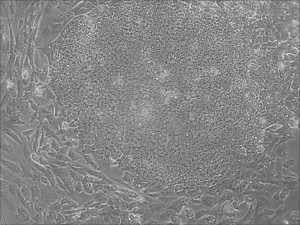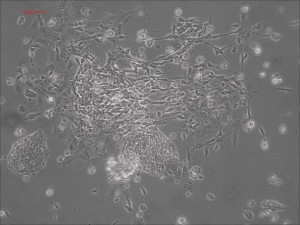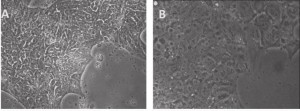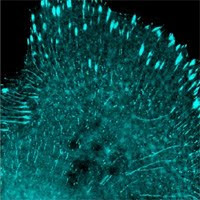来源:南方周末 作者:彭令范
林昭(1932-1968)遗照。 (南方周末资料图/图)
 编者按:彭令范女士是林昭的妹妹,她这篇文章,详细披露了林昭案历经两次复查,方得平反的过程。读后我们才知道,主持林昭案平反的上海高院院长关子展,原是彭令范在上海第二医学院的老领导,如果不是有此机缘,林昭要脱去“精神病”的罪名,恐怕还要经历很多波折。
编者按:彭令范女士是林昭的妹妹,她这篇文章,详细披露了林昭案历经两次复查,方得平反的过程。读后我们才知道,主持林昭案平反的上海高院院长关子展,原是彭令范在上海第二医学院的老领导,如果不是有此机缘,林昭要脱去“精神病”的罪名,恐怕还要经历很多波折。
彭令范女士现居美国。
林昭难友张元勋去世后,彭令范填了一首词聊表纪念,这里一并发表,以飨读者。
1979年2月28日,我收到北京大学党委寄来的姊姊林昭的右派分子改正通知。这时我想到,应该向有关部门申请复查和平反林昭的反革命罪和死刑判决,同时也必须为我母亲许宪民(1908-1973)的“反革命分子”罪名平反。
母亲受到牵连
“文革”前,我母亲是“民革”苏州市委副主任、市政协委员、中国民主同盟盟员、苏州市汽车公司副董事长、苏州公共汽车公司副经理,她在1949年
后的历次运动中幸存了下来,但在“文革”中却为了林昭的缘故,也成了反革命分子,死于非命。她的平反须通过高一级——江苏省的有关部门甚至民主党派的中央
批准核定。
我同时做这两件事(母亲和姊姊的平反),必须尽一切努力。在那个年代,我用了几乎所有的时间,写了几百封信给我以为能给我们帮助的人,用菲薄的工
资从上海跑南京,跑北京,找寻和访问所有和我母亲、姊姊有关的人,大多数是母亲的同志和朋友,有些是中共党员,在毛泽东去世、“文革”结束后,官复原职,
同时我也作了一些调查研究,找出原始资料和有用证物。没有任何人帮助我做这件事,人们不敢涉及这棘手的问题,包括我的亲弟弟。我完全靠自己做这事,只有上
帝照看着我。
我母亲的追悼会于1980年2月10日在苏州举行,与会者百余人,不无知名人士,如孙中山第八位秘书田桓、台湾裕隆汽车公司老板的长兄严庆祥等,不胜枚举。另外还有来自全国各地的百余份唁电、挽联。《苏州日报》报道了这一新闻,母亲再一次被称为同志。
第一次复查
姊姊的平反过程是非常错综复杂的,并带有一定的神秘色彩。1980年8月22日,我收到上海市高级人民法院寄来的《刑事判决书》(沪高刑复字第435号),判决书虽然宣告林昭无罪,但给出的理由却是:
现经本院复查查明:林昭在1958年被错划为“右派份子”后,因精神上受到刺激,1959年8月开始就患有精神病,嗣后,曾以写长诗、文章等表示
不满,并非犯罪行为。1965年对林昭以反革命罪判徒刑显属不当,应予纠正。林昭被错判服刑后,精神病复发,又曾用写血书、诗歌、日记以及呼喊口号表示不
服,1968年将林昭在病发期间的行为,又以反革命罪处以极刑,显属错杀,应予纠正。据此,本院特重新判决如下:
一、撤销上海市静安区人民法院1962年静刑字第171号和中国人民解放军上海市公检法军事管制委员会1967年度沪中刑(一)字第16号两次判决。
二、对林昭宣告无罪。
所以这里是错划“右派分子”,错判“反革命”服刑,错杀,三错到底,主要归咎于她的“精神病”。我并不认可这平反的“措词”,但当时只能得到这样
的平反判决。因为林昭的“精神病”,法院没有发还家属任何遗物。我曾去信要求发还一些她的遗物(我的目标是她的遗稿),但杳无音讯。
然而奇迹出现了!我所在的上海第二医学院(编者注:1952年院系调整中由圣约翰大学医学院、震旦大学医学院及同德医学院合并而成)的党委书记兼
院长、“党内走资本主义道路的当权派”关子展(1914-1996),“文革”后恢复名誉任上海市高级人民法院院长(编者注:关子展在1979年12月
30日结束的上海市第七届人民代表大会第二次会议上当选为市高级人民法院院长),当我看到他的任命在报上发表后,我立即写信给他。
彭令范赠给胡佛研究所的林昭案卷 (南方周末资料图)
 我与关子展的相识
我与关子展的相识
我与关子展的相识,很有戏剧性。
1973年我母亲去世后,我体内各种生理系统不平衡,经常生病,1976年经急诊住入我们医学院附属的广慈医院(编者注:今瑞金医院前身)。当我
的病情略见好转后,就帮医生护士做些简单的工作。有一天,我到一个小房间给病人发药,一开门,我惊讶地叫道:“关院长!”“我已不再是院长了,”他说。
“不,你是我们的院长,我的院长。”我答道。当时他罹患高血压、心脏病,因为是“党内走资本主义道路的当权派”,在当时是重点打击对象。自此以后,我和关
院长逐渐熟悉和接近。
我们谈医学,他问我:“你是否是好学生好医生?”
我说:“当然。”
他说:“我要问你老师……”
有时他会对护士说:“叫728(我的病床号)来看我。”当时他虽然被允许住进他领导下的医学院附属医院,带有“保护”性质,但被与外界隔离。我是
医生,有些“情报渠道”,所以会告诉他一些敏感消息或道听途说的小道新闻(有时小道亦来自大道)。我尊敬他是我们学院的院长,这本来是人之常情,但这种常
情却超出了“文革”的常情,大概给他留下了良好的印象,中间没有任何政治因素。我从未想到,有一天他会给予我难以想象、不可思议、出乎意料的帮助,使我终
生感激难忘。
林昭的追悼会
我写了好几封信给关子展。第一封是1980年8月26日,然后是同年9月2日和9月26日,提出为林昭开追悼会的要求,同时希望在他的领导下,重新复查林昭案件。我用外交词令暗示,以精神病为由平反似不符实际。
如果不是关院长,其他人大概不会为“精神病”操心,因为林昭已经得到平反了。
结果在1980年12月11日,林昭追悼会在北京中国新闻社召开。与会者有全国政协副秘书长聂真、北大林昭的老师们,还有苏南新闻专科学校、北京
大学、人民大学林昭的同学,以及林昭在人大资料室监督劳动时遇到的刘少奇前夫人王前等,共百余人。我保留了追悼会的录音磁带和所有资料,包括来自全国各地
的唁电、唁信和挽联约八十余份。
参加追悼会大多数人,都希望我能全力去为林昭的“精神病”平反,“只有你能做这件事!”这是人们对我的期待。
《人民日报》报道“子弹费”
1981年1月27日,《人民日报》发表了报道林彪、江青集团案审判情况的长篇通讯《历史的审判》(由新华社总编辑穆青与郭超人、陆拂为合写),其中有一段提及林昭的案件:
她(林昭)就义的详细经过至今无从查考,我们只知道这样一个消息:1968年5月1日清晨,几个“有关方面”的代表找到了她年迈的母亲,宣告林昭
已于4月29日被枪决。由于“反革命分子”耗费了一发子弹,她的家属必须交纳五分钱的子弹费。这真是使人毛骨悚然的天下奇闻!在中世纪被判“火刑”烧死的
犯人无须交付柴火费,在现代资产阶级国家用“电椅”处死的犯人也从未交过电费,唯有在林、江的法西斯统治下,人们竟要为自己的死刑付费,这不能不说是又一
个“史无前例”的创造发明!也许在若干年以后,我们的后代对上述这一切将难以置信,但不幸的是,它确实是发生在我们这一代人生活中的事实。我们每一个活着
的人,都曾经为它感到极度的羞耻。
《人民日报》面向全世界发行,并有各种不同语言的翻译,所以林昭的故事,特别是五分钱子弹费的故事,早在1980年代已在国外流传,我曾看到几个地方(法国等)提及。
这篇通讯发表后,上海公安局很恼怒,“肯定是林昭的那些记者同学干的(写的)!”诚然,陆拂为是林昭北大、苏南新专的两度同学。
再一次复查
1981年2月10日,上海静安区人民法院赵凤岱找我去谈话,他当时是复查组组长,他首先问我林昭的精神状态,“你是医生,你如何看她的精神状
态?”“她去上海精神病总院鉴定过数次,但她仍关在监狱里,没有住精神病院。”我答道。赵先生是一个正派的人,后来我们彼此配合、理解甚佳。有一天,他对
我说:“第一次见到你时,你的眼睛里充满了怒火。”
1981年3月,陈伟斯先生写了最早关于我姊姊的文章《林昭之死》,发表在上海《民主与法制》杂志上。复查组组长赵先生让陈伟斯看了一房间林昭的
档案,只能看,不准抄录,以一天为限。陈伟斯大概是政治系统之外、唯一看到这些档案的人。陈先生是我母亲的同志和朋友(我称他陈叔叔),中共党员、新闻记
者,也是右派分子,曾在劳改营被劳教20年。平反后,重新回到新闻界工作。
与此同时,赵先生曾多次提及“我们的院长对林昭案非常关心并直接参与”。1981年12月30日,我收到上海市高级人民法院的另一份判决书:
本院于1980年8月22日复查……对林昭宣告无罪在案。经本院院长发现,本案改判判决在适用法律上仍属不当,由审判委员会决定再审。
现经本院再审查明:林昭于1958年在北京大学读书期间被错划为“右派份子”,于是以写长诗、文章等表示不满;1968年林昭在被错判服刑期间,
又先后用写血书、诗歌、日记以及呼喊口号表示不服。按林昭以上行为,根本不构成犯罪;而上海市静安区人民法院和中国人民解放军上海市公检法军事管制委员会
均以反革命定罪处刑是错误的。本院于1980年8月22日复查改判时,否定林昭犯有反革命罪,撤销原来两个错误判决,对林昭宣告无罪是正确的。但据以宣告
无罪的理由是说林昭因患有精神病,在病发期间的行为,不应以反革命罪论处。如上所述,林昭的行为既不构成犯罪,故本院(80)沪高刑复字第435号判决在
适用法律上亦属不当,均应与前两个判决一并予以纠正。据此,本院判决如下:
一、撤销本院(80)沪高复刑字第435号、中国人民解放军上海市公检法军事管制委员会1967年度沪中刑(一)字第16号和上海市静安区人民法院1962年静刑字第171号判决。
二、对林昭宣告无罪。
这次复查,不仅去掉了“精神病”的借口,并加以否定。至此,林昭的平反,最终完成了。我没有辜负人们对我的要求。
1982年3月,我收到赵凤岱先生发还我的林昭给人民日报编辑部的信137页。
我从来没有对任何人讲我认识关院长和他在林昭平反中的作用。直到1999年,我写了一篇《我的姊姊林昭》发表在苏南新专的“五七年情缘”专刊上,
约略地提到这事,现在又14年过去了,我应该把这件事讲清楚,在那个年代中,谁帮助使林昭获得了平反,取得了林昭的案卷。
我从来没有机会感谢关院长。他给我的帮助,我铭记终生,感激不尽。但我认为他有一个真正共产党人的良知,捍卫法律的尊严。
神秘人物的馈赠
1982年春末的一天,我们医院党支部书记对我说:“明天下午2点你要到上海公安总局去一次,有人要找你谈话。”“什么主题?”我问道。“你去了就会知道。”“去找谁?”我再问。“没有名字,你准时到,讲你的名字就可以了。”
次日,我到了那里,通报姓名之后,警卫把我领到一个邻近公安总局入口处的办公室。几分钟后,一个四十岁左右、表情阴郁的人走了进来,他注视了我两秒钟,“你是林昭的妹妹?”他问道。“是的。”我说。然后他就开始讲述。我感到很意外,他没有问我任何问题。
“我希望你知道,你姊姊的案例自始至终我们有两种不同的意见,从在监狱里如何对待她(注:林昭被反铐484天),到最后判决死刑,甚至她的平反,
都是非常复杂的过程,可能你也知道一些。因为你姊姊的案子,有些干部丢了工作,甚至坐了牢,下场很悲惨。”我不知道如何应答,也不明白他为什么告诉我这些
情况。我没有准备应该怎么讲,也是怕讲错,“所以有两个司令部?”这是我在这次会见中唯一的几句话。
然后他继续讲:“你姊姊的死刑判决,是中央政治局作出的最后决定。”室内死一样的寂静。我感到空气似乎凝结成冰。我们两人都没有什么要说的了。或者应该说,在任何关键性的时刻,语言都是无力的。
最后,他说:“这里有几本笔记,你姊姊的日记和写作摘要。你大概希望能保留。”“是的,当然!”我答道,“这是不是她的笔迹?”他问道。“是的,
这正是她的笔迹!”然后他问,“你有什么要讲吗?”“没有,感谢你给我她的笔记。”我没有敢问他的名字,我想他也不会告诉我。
这就是林昭三本笔记簿日记和其他资料的来源。
1.《战场日记——留给公众和后世的记录(1967.2.9-2.23)》
2.《血书家信致母亲附血书抗议(1966.10.4;1967.10.14-1968.1.14)》
3.《心灵的战歌,我呼吁人类(1967.11.23-30)》
4.《课卷(1966.1.11-2.27)》
我非常感谢这位神秘的知情人物向我透露林昭案的一点儿内幕,他给我的这些可贵的日记和“课卷”,填补了姊姊狱中生活的空缺,也提供了研究中国近代
史中那些铁腕政治人物的重要线索,同时告诉我们如何研究林昭的案卷。2009年10月,我把这些遗稿和林昭给人民日报编辑部的信,捐赠给了斯坦福大学的胡
佛研究所。
我常常为此人祈祷(虽然或许他并不需要我的祈祷),他大概是一定级别的公安干部,但他仍具有正派、合乎礼仪的人性和善良的道德观念。他给我林昭的
笔记,只因为我是她的妹妹,但或许他要让这世界了解某些内幕,在未来的岁月为历史研究提供线索和暗示。(小标题为编者所加)
小档案
关子展(1914-1996),山西霍县人,1936年参加革命,曾任晋中公安局侦察科长、太原市公安局办公室主任、山西省公安厅调查研究室主
任、华北局社会部办公室副主任等职,1954年调公安部任办公厅副主任、人民防空局局长。1957年调任上海第二医学院党委书记兼院长。1977年任上海
市教育卫生办公室副主任,1978年当选上海市七届人大代表,上海市政协常委,中共上海市市委委员,同年任上海市高级人民法院院长、党组书记。1983年
当选上海市八届人大常委、法制委员会主任。
临江仙·悼张元勋
四十余年弹指去,人间天上茫茫。平生细诉九回肠。营营从楚辞,几度历风霜。劫后风华依旧在,中途不思归航。尘寰错落复流光。麟儿椿萱慰,何必话沧桑。













